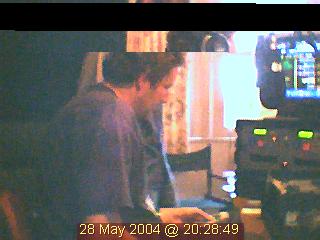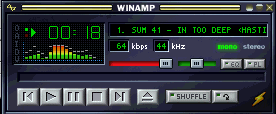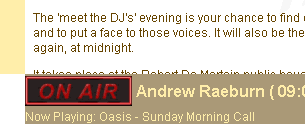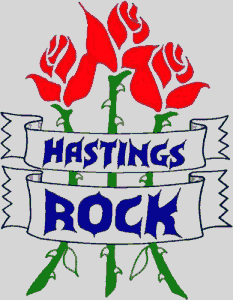
| About |
| Broadcasters |
| Free Trial |
| Purchase |
| News |
| Documentation |
| OAS Audio API |
Hastings Rock - UK RSL
|
|
Hastings Rock were the first radio station to use OAS Playout. They operate as a Restricted Service License (RSL) radio station in the UK in the (surprisingly) Hastings area of East Sussex. RSLs are allowed a limited broadcast period usually of 28 days - Hastings Rock in general are on air for this period every one or two years. Up until the 2002 broadcast, Hastings Rock the station was principally CD based for music with jingles and advertisements being held on minidisk. Late in 2001 they decided to try out a computerized playout system, opting to store all their mainstream music along with ads and jingles on the system. Due to one of the jocks beta testing an early version of my playout system, I was asked if they could trial the software for the broadcast this year. They also asked if I would setup the computer system for the station. The original OAS Playout V1 was used successfully for the first time throughout the May 2002 broadcast and the latest V2 release is now being used for their 10th year anniversary broadcast. |
The official Hastings Rock website is http://www.hastingsrock.co.uk
OAS Playout is a dual output MP3 audio playback package which started life in early 2001. After trying a beta copy of the software, the station opted to use this for their playback system and convert all their existing music and jingles to MP3 for computer storage. The MP3 audio format is a highly compressed means of storing digital audio in almost near CD quality - your average PC can hold in the order of 2500 tracks in this format.
The May 2022 broadcast marked the 20th anniversary of being involved with Hastings Rock both in terms of OAS Playout being used as their primary playout system and of generally being responsible for the whole IT infrastructure of the station.
A lot has obviously changed during those 20 years and certainly the remote broadcasts that were made in 2020 and 2021 due to Covid restrictions would have been impossible back then. In some ways though, the core setup remains unchanged from that I described back in 2002. We still utilise a Linux server with removable drive holding the music with a backup one installed in the studio PC (although today we use removable SATA solid state drives instead of the old PATA ones which were never that reliable). And that server still provides the internet gateway as outlined in my write up for 2004 (the first year we had a permanent broadband connection). One significant thing that has changed though is that for many years now we've not had the need for an off-air studio. With the advent of fast broadband pretty much the norm nowadays, audio content can simply be generated and then uploaded to the system remotely. Of course much of the audio content in those early years came from ripping CDs whereas nowadays it's almost all downloaded from the Internet.
A key changed happened way back in 2006 which was the switch from using Microsoft Access as the database engine for Playout (which remains the default for standard installs due to it's simplicity) to MySQL. This was principally to introduce what was (and still is I think) the fairly innovative online listener requests capability which is used during periods of automation, typically overnight betwen midnight and 6am. That move to MySQL also yielded additional benefits, we soon started operating a database replication between the Linux server and studio PC which ensures that in the event of the server failing, it's possible to switch to a local database that is fully up to date. In more recent years, we now host the database 24/7 in the cloud, with replication to/from the studio copy during the broadcast periods. That simplifies access for everyone involved and adds an extra layer of redundancy.
Playout itself has continuosly evolved since then, as my original trial log from 2002 shows, Playout Manager didn't even exist then, we were working directly with the Microsoft Access tool itself to import the data. Since then, many of the new features and released debuted on the station prior to being released to the wider world and in 2020, we used, as the central broadcast point a Linux version of Playout running on a Raspberry Pi which was another first.
Next year the station itself celebrates 30 years of broadcasting and Playout will continue to be a key part of the broadcasting infrastructure.
May 2004
Overview
This year for the first time we have a permanent internet connection available so that and a long overdue upgrade to the music server has resulted in a slightly different (and somewhat more complex) infrastructure - principally to deal with the security issues of having the system exposed to the internet. There's a bit of a technical write up on what's been changed here for those interested.....
Internet streaming will also been in place once again via external Shoutcast clusters and with the studio now having a permenant connection available, OAS Playout will be providing the Title/Artist information of the current track to all the servers for display within Winamp and on the Hastings Rock website.
For the first time since it's conception in 2001, Playout has been used on a number of other RSLs since the last broadcast. This has helped evolve and further improve confidence in the product taking it to the latest release (2.4) which will be used on Hastings Rock. As last year, there has been little in the way functional changes for this release notably because of the time dedicated to develop OAS Playout Manager (the 'off line' management software). Of significance though, particularly following the audio 'hiccups' encountered last year and following similar effects occuring during some of our trial webcasts, the audio 'core' central to Playout has been substantially enhanced to minimize the effects caused by slow or unreliable networks. That and the improved audio file server in place (along with other security issues) means the setup will use network to source (as originally intended in 2003) the audio rather than a local disk.
The Broadcast
|
|
All in all it has to be said another successful broadcast from a technical perspective - there were a few glitches, as there often is but nothing of a show stopping magnitude. Possibly the closest to that was the failure of one of the sound cards in the studio PC during week 2 (1 day before I departed on holiday which was fortunate), we aren't too sure what exactly happenned "the screen went black" and "everything stopped working" was about as good as informative as it got. Having swapped the failed SBLive with the one in the prep studio all was well again, although the "failed" one then sprang back into life when re-installed in the prep PC. One of life's mysteries that one. |
|
Hastings Rock Studio - May 2004
|
On the Playout side, only thing of note is (and I'm coining this phrase), "track slippage". For some bizarre reason and at fairly random intervals the odd track appears to jump say quarter or half a second - blink and you'd miss it. It was going to be difficult to track down on a "live" system and I didn't devote too much effort to it particularly as I've not seen it here on two similar Win2k setups and since nothing that radical has changed on the decoding front since last year I'm inclined to blame some other aspect of the studio PC. It wasn't the "clean" install from last year, rather it's had a variety of stuff added since then (including 2 virus checkers!) belonging as it does to the station controller. Unfortunatly I never got a chance to stress test it here before air date. The effect has however been seen before on a Win98 setup using some very bespoke sound cards & old DirectX drivers - whether the two things are related is subject to some debate. Keep an eye on the development page to see if anything more comes of this.
 oops... |
In an effort to solve the "slippage" effect, the webcam (running on the studio) PC was disabled, which over a period of days significantly diminished (the jury was out on whether it has totally eliminated) the problem - again leading credence to the "other stuff running on the PC breaking it" theory. When replacing the damaged sound card, I also attempted to turn off the virus checker(s). A side effect of all this of course is that the webcam had to be relocated on another machine - in this case the only one available being the P120, heavily firewalled email machine. As expected it wasn't really man enough for the job with generally half complete/broken up images appearing at regular intervals. |
The other issue with the webcam hosted on the email machine was breaching the firewall - for security reasons this machine only had restricted access to the internal network so not only did further access need to be provided, some mechanism of uploading the image onto the website was needed. I had a play with several ftp proxy programs (notably frox running on the Linux server) but had very little success in getting the webcam app. to co-operate (a reasonably nice freeware program called fwink) - it locked up 9 times out of 10 although I'm not ruling out the ancient PC it was running on. In the end, the images were ftp'd locally to the Linux server then uploaded regularly via a script. Messy but it worked. Before leaving the webcam buried, the other thing of note was the 'Webcam 24' page which appeared mid way through - our webmaster chap had seen a site do something similar and thought it would be entertaining. In our case it's once again performed by the Linux server running a script to copy/rename the last image up every hour.

As mentioned earlier, with Playout providing the Title/Artist details to the top level Shoutcast servers we use for net streaming, this information is then fed out for display on the Shoutcast home page, on the MP3 Players (Winamp) and with a bit of server side scripting, on the Hastings Rock site itself.
 |
 |
We didn't get as far as displaying the 'last 10 tracks' played list but this too is available by interrogating one of the Shoutcast servers. For the website display a PHP script is executed every minute on an Apache Linux webserver hosting one of the Shoutcast servers. This machine is also responsible for the Listen Live side of things in determining which server to connect to.
Another new addition to Playout this year was the ability to keep logs (in the database) of all the music played - from this a wealth of useful (useless?) information can be generated, both from Playout Manager (in the form of most popular/requested track) and through using MS-Access Reports and graphs to depict a variety of statistics. No doubt some of this will be appearing on the Hastings Rock site in the not to distant future.
I'd like to say Playout was up and running solidly for the whole 28 days but what with the sound card failing, webcam bits and pieces there were a number of reboots involved. However it did clock up many hours of continuous use, including overnight automation (another first this year) all without any problems. As usual a number of improvements and suggestions were gleaned, notably at the end of broadcast party of which I have probably forgotten most due to the amount of alcohol flowing at the time....
Overview
Another successful broadcast by Hastings Rock this year, again powered by OAS Playout. Technically the computer infrastructure deployed is almost identical to last year - the "toaster" has been dusted off and put back in the kitchen although there has been less of a last minute dash in sorting out the music. This year the station was streamed out on the 'net via a Shoutcast cluster of 10 or so ADSL connections.
The latest release of OAS Playout (2.0) along with the database management software (OAS Playout Manager - still a Beta release mind you) was used this year. Visibly (and operationally) OAS Playout hasn't changed too much since last time, everyone seemed happy with the interface so beyond a few more bells and whistles the transition wasn't too difficult. More significantly is there has been a complete overhaul to the innards to interface to a new MP3 decoder engine. The original version of Playout used a third party decoder which as it transpired would be prohibitively expensive to distribute. There were also suggestions made last year that the sound quality was lacking somewhat. Therefore this year a new, freeware decoder is being used which has resulted in significant changes inside Playout in order to use it so in a sense the software is almost as new as it was first time round. It's also enabled some of the more annoying audio related bugs (such as the spurious 'pauses' incurred when a track is played) to be fixed which would have been impossible if the older decoder were still in use.
The other significant change is the dedicated database management software (OAS Playout Manager) has been written and although still in a beta release state (it's only been in existence since December last year) will hopefully resolve many of the problems and complications which occured last year in getting audio in and out of the system.
Technically, we had a few difficulties during the first week with audio 'hiccuping' notably during periods of increased network traffic to the music server. Whether this was due to the differing IO demands of my new MP3 decoder, tweaks I made to the server or faster machines hanging on the system is unclear however after a brief re-configuration session at the beginning of week 2 which resulted in the music being played from the local disk all was well. Clearly "toaster", the old P120 server has had it's day and something with a little more speed will be required for next time..
Aside from that, everything performed remarkly well, no crashes and everyone seemed well pleased. The 'prep' machine was even relocated into town to source the audio for the end of show party. Once again a few suggestions for improvement of the main software came along (which are always welcome). A few issues arose using the new Playout Manager software - the Playlist manager still needs work and there were a few program crashes which bear investigation however considering the relative newness of this part of the package it also performed pretty well.
This was the first time OAS Playout has been used on a UK station & therefore this was (from not just my perspective) a big step - RSLs aren't cheap to setup and in the space of a little under 5 months a completely new and relatively untested solution was going to be in use 18 hours a day with only a fraction of the normal CDs on hand should it all go to pot. However in the end I felt it all went well and was a good proving ground for my software.
Here you can read up on the technical information, notes and logs from the 2002 broadcast along with comments and thoughts from the folk using it - many of which have gone into the latest release.
Hastings Rock used OAS Playout v1.0 (the xaudio based variant).
| Technical Overview | The technical description, how the PC side of things hangs together. |
| Installation | Putting it together, setting up the studios |
| On-Air - Trial log | How it all went.... |
| OAS Playout | The home page for OAS Playout |
